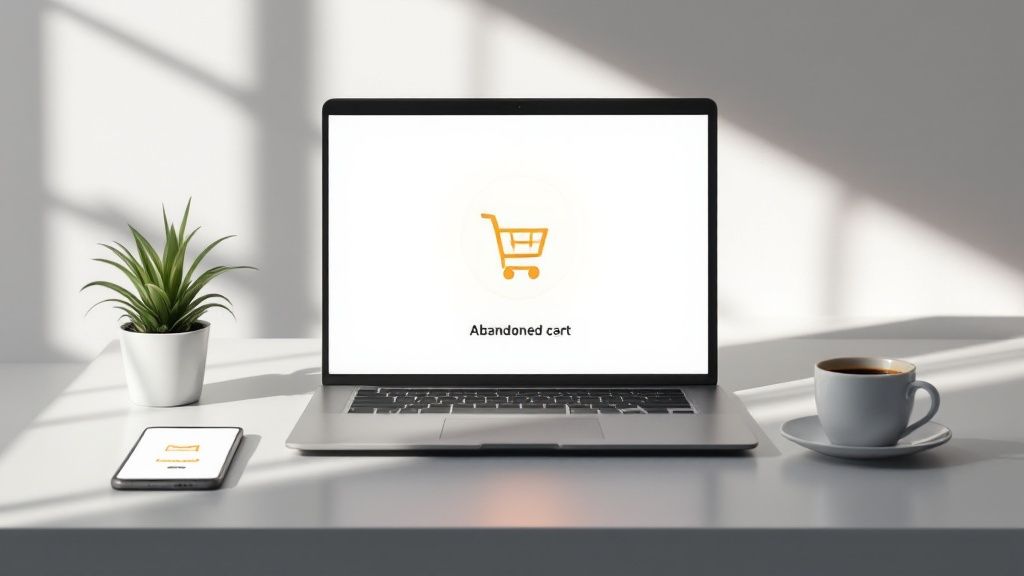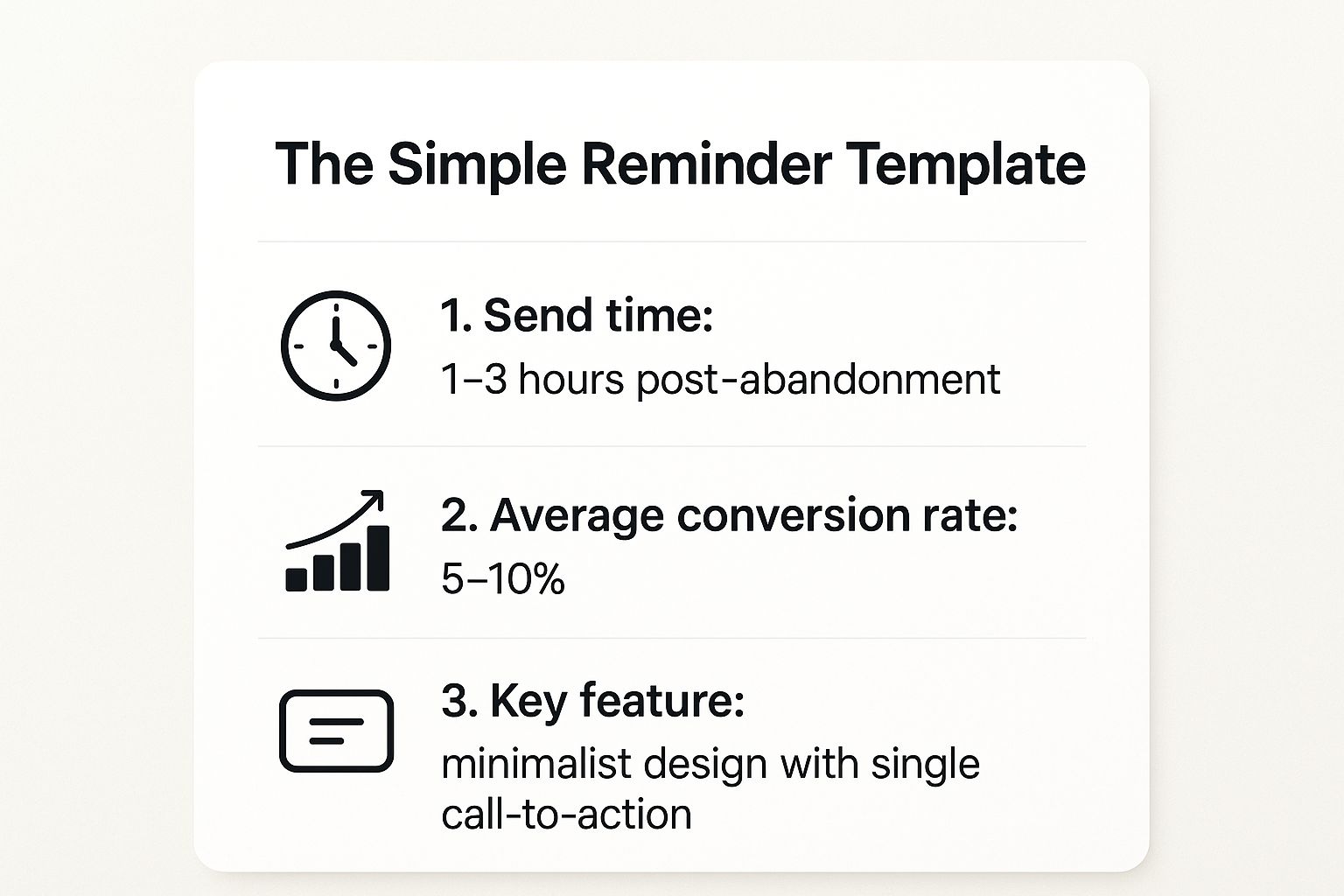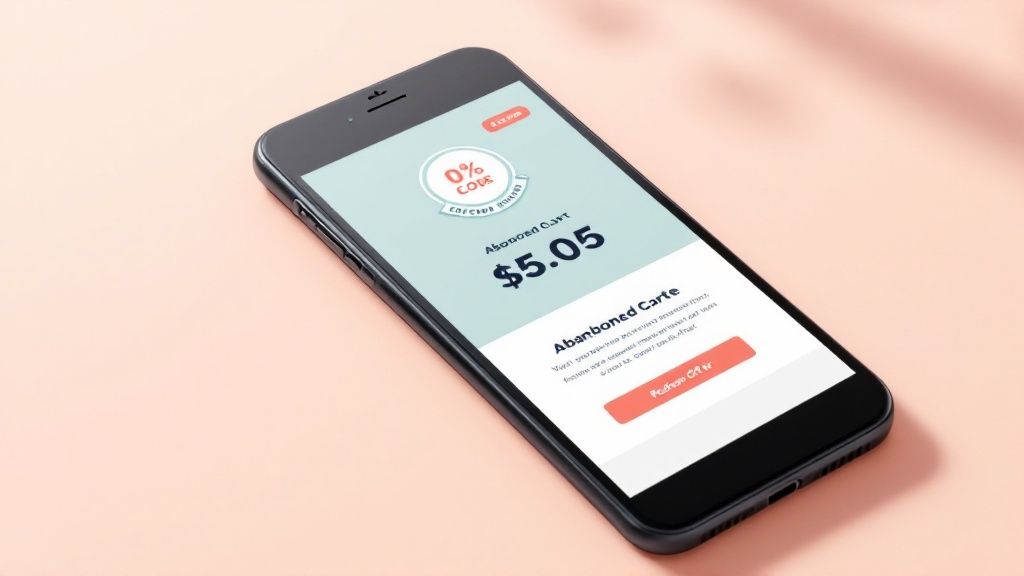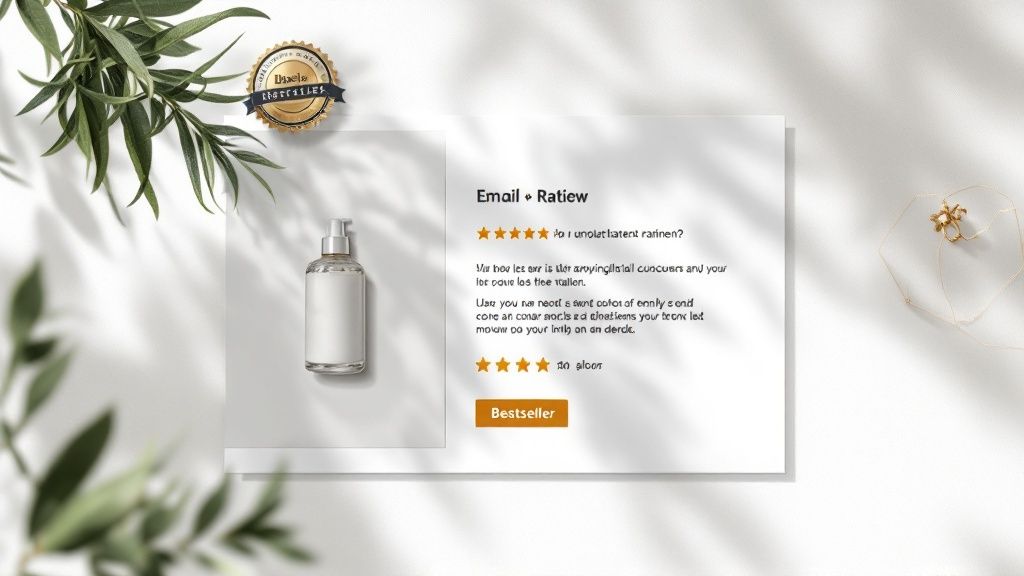Effective Abandoned Cart Email Templates to Boost Sales
May 4, 2025

Reclaim Lost Revenue with Powerful Abandoned Cart Emails
Abandoned cart emails are essential for recovering lost sales. This listicle provides six effective abandoned cart email templates to win back customers and boost revenue. Learn how to use the Simple Reminder, Discount Incentive, Social Proof, Question-Based Feedback, Scarcity/FOMO, and Humor/Personality templates. We'll explore the pros, cons, and examples of each, helping you choose the best abandoned cart email templates for your Shopify store and maximize conversions.
1. The Simple Reminder Template
The Simple Reminder abandoned cart email template is a highly effective, straightforward approach focused on gently nudging customers back to complete their purchase. It avoids overwhelming them with excessive information and instead prioritizes a clear and concise message. This template typically includes a high-quality image of the abandoned product(s), a friendly reminder message acknowledging the items left in their cart, and a prominent call-to-action (CTA) button that seamlessly redirects customers back to their cart for checkout. This simplicity makes it easy to implement and highly effective, particularly for first-time abandoners.

The infographic above visualizes the core components of the Simple Reminder template, highlighting its minimalist design, clear CTA, and concise copy. The emphasis on product imagery and personalized greeting underscores its effectiveness in re-engaging customers without being intrusive. This approach leverages the power of a gentle nudge, capitalizing on the customer's initial interest in the product.
Companies like Warby Parker and Dollar Shave Club have successfully implemented this strategy. Warby Parker’s abandoned cart emails feature simple product imagery with a clear "Return to Cart" button, while Dollar Shave Club uses casual, friendly language in their reminder emails with minimal distractions. These examples demonstrate the effectiveness of a clean, direct approach.
This template deserves its place on this list due to its proven high conversion rate attributed to its simplicity. Its key features include a minimalist design centered around the abandoned products, a single, clear call-to-action, short, conversational copy, product images with direct links to the cart, and a personalized greeting using the customer's first name. These features contribute to a user-friendly, mobile-optimized experience, making it accessible and convenient for customers to return to their purchase.
Here's a quick reference summarizing the key takeaways of the Simple Reminder template:
- Goal: Gently remind customers about their abandoned cart.
- Focus: Product image and clear CTA.
- Messaging: Concise, friendly, and personalized.
- Best for: First-time abandoners and simple products.
These key takeaways highlight the core strengths of this template. Now, let's explore some actionable tips for implementing this strategy effectively.
For optimal results, send the email within 1-3 hours of cart abandonment. Personalize the subject line and greeting with the customer's name to enhance engagement. Keep the email focused on a single action: returning to the cart. A/B test subject lines that create a sense of urgency without being overly pushy (e.g., "Still thinking about it? Your cart is waiting!"). And critically, ensure the cart contents are accurately displayed to avoid confusion.
While the Simple Reminder template boasts numerous advantages, including high conversion rates, quick implementation, and mobile-friendliness, it's also important to acknowledge its limitations. It may lack compelling incentives for price-sensitive customers and offers limited opportunities for brand storytelling. This approach may not be ideal for high-consideration purchases requiring more detailed information, and it can feel generic if personalization isn't properly executed. However, for many e-commerce businesses, especially those selling lower-priced items or targeting first-time abandoners, the Simple Reminder template remains a powerful tool for recovering lost sales.
2. The Discount Incentive Template
The Discount Incentive Template is a powerful tool in the arsenal of abandoned cart email templates. This strategy leverages the allure of a price reduction to entice customers to complete their purchase. By offering a limited-time discount or special offer exclusively for the items left in their cart, you create a sense of urgency while providing that extra nudge for price-conscious shoppers. This template excels at converting hesitant shoppers into paying customers.

This template typically features a prominent discount code or offer, often in the range of 10-15% off. To amplify the urgency, it often includes a countdown timer or a clearly stated deadline for the offer. Furthermore, it can include product recommendations based on the abandoned cart items, further enticing the customer to explore and potentially add more to their order. Clear instructions on how to redeem the discount are crucial, and including shipping information or policies can further alleviate any purchase anxieties. Successful implementations of this strategy can be seen with brands like Adidas offering 15% off abandoned cart items with a 24-hour countdown timer, Bonobos sending a 20% discount code with personalized product images, and Casper offering free shipping on abandoned mattress purchases within a 48-hour window. These examples demonstrate how tailoring the discount to your product and target audience can maximize its impact.
For Shopify store owners, e-commerce managers, Shopify Plus brands, and email marketers, understanding the nuances of the Discount Incentive Template is essential. Its strength lies in its high effectiveness for price-sensitive customers. The time-limited nature of the offer creates urgency, significantly increasing conversion rates. Tracking the effectiveness is straightforward through coupon code usage, allowing for data-driven optimization. Furthermore, this template works exceptionally well as a second or third email in an abandoned cart sequence, giving customers who didn't respond to the first reminder an added incentive. Learn more about The Discount Incentive Template and best practices for abandoned cart emails.
However, there are potential drawbacks to consider. Overuse of this tactic can train customers to intentionally abandon carts in anticipation of a discount, potentially impacting profit margins. It's also less effective for luxury or high-end brands where discounting might dilute brand perception. Therefore, careful planning of your discount strategy and customer segmentation is crucial. You should avoid sending discounts to loyal customers who frequently purchase at full price. Calculate your margin threshold beforehand, and test different discount amounts and durations to find the optimal conversion point without significantly eroding profits. Using unique, time-limited coupon codes reinforces the urgency and allows for accurate tracking of each campaign. This approach ensures that you leverage the power of discounts effectively while mitigating potential risks. This template deserves its place in the list of abandoned cart email templates because it offers a direct and often highly effective way to recover lost sales. Its targeted approach, combined with the psychological impact of a limited-time offer, makes it a valuable tool for any e-commerce business.
3. The Social Proof Template
The Social Proof Template for abandoned cart emails leverages the power of testimonials, reviews, and ratings to nudge potential customers towards completing their purchase. This tactic relies on the psychological principle of social proof, where people are more likely to take an action if they see others doing the same. By showcasing positive experiences from past customers, you can build trust, alleviate purchase anxiety, and ultimately recover lost sales. This is a particularly effective strategy for abandoned cart email templates as it provides reassurance and validation at a crucial point in the customer journey.

This template is especially valuable for Shopify store owners, e-commerce managers, Shopify Plus brands, and email marketers looking to optimize their abandoned cart recovery strategies. Features like prominently displayed product ratings and star reviews, customer testimonials specific to the abandoned products, user-generated content (photos and videos), “Bestseller” or “Popular Choice” badges, and statistics on product popularity or sales volume all contribute to its effectiveness.
Companies like Wayfair, Casper, Glossier, and Brooklinen have popularized the use of social proof in abandoned cart emails, demonstrating its potential to boost conversions. For instance, Casper strategically incorporates customer testimonials about sleep quality in their mattress recovery emails, while Glossier leverages user-generated content and before/after photos. Brooklinen, on the other hand, emphasizes their "over 100,000 5-star reviews" to build confidence.
Pros:
- Builds trust and credibility through third-party validation.
- Addresses potential concerns that may have caused cart abandonment.
- Particularly effective for high-consideration or expensive purchases.
- Helps overcome objections without direct selling.
- Can increase perceived value without resorting to discounts.
Cons:
- Requires a robust review collection system already in place.
- Less effective for new products with limited reviews.
- Can appear cluttered if too many reviews are included.
- May not directly address specific pricing concerns.
Tips for Implementation:
- Select the most relevant reviews: Choose testimonials that address common objections or highlight key product benefits.
- Show recency: Include the review date to demonstrate that the feedback is current and relevant.
- Verify purchasers: Feature reviews from verified buyers to enhance credibility and trustworthiness.
- Test demographics: Experiment with including reviewer demographics (age, location, etc.) to improve relatability.
- Stay focused: Keep the social proof centered on the specific abandoned products to maintain relevance.
When and Why to Use This Template:
This abandoned cart email template is ideal for products with existing positive reviews and testimonials. It's particularly impactful for items with higher price points or those requiring a greater degree of consideration before purchase. By showcasing the positive experiences of others, you can effectively address hesitation and encourage customers to complete their purchase. If you're struggling with high cart abandonment rates and have a solid collection of customer reviews, the Social Proof Template is a valuable tool to incorporate into your email marketing strategy.
4. The Question-Based Feedback Template
This abandoned cart email template takes a customer-centric approach, prioritizing understanding why a shopper abandoned their cart over immediately pushing for a sale. Instead of bombarding customers with discounts, the question-based feedback template politely inquires about the reasons behind their decision. This method builds rapport and demonstrates that you value customer input, providing a valuable opportunity to address specific concerns that led to the abandonment. This makes it a powerful tool in your arsenal of abandoned cart email templates.
This template typically features a simple survey or a few direct questions about the reason for abandonment. For instance, it might ask, "What prevented you from completing your purchase?" and offer multiple-choice options for easy response. A direct reply option to customer service is crucial, allowing for personalized assistance. While subtly reminding the customer of their cart contents, the email's primary focus remains on offering help rather than pushing for an immediate purchase. Often, these emails also include a FAQ section addressing common concerns like shipping costs, return policies, or payment security.
Examples of Successful Implementation:
- Everlane: Asks "Was there a problem with your order?" with simple "Yes" or "No" buttons, leading to further inquiry if needed.
- Bellroy: Uses "What stopped you from completing your purchase today?" with common reasons like "Just browsing," "Shipping costs too high," or "Found a better deal elsewhere."
- Chewy: Includes a prominent "Questions about your products? Ask our experts" section, encouraging direct interaction with their customer service team.
Pros:
- Collects valuable data: Understanding why customers abandon carts provides actionable insights to improve the customer journey.
- Demonstrates customer-centricity: Asking for feedback shows you care about the customer experience and are actively working to improve it.
- Opens a dialogue: Initiating a conversation can lead to conversion and build stronger customer relationships.
- Identifies website or product issues: Feedback can pinpoint problems with your website, product descriptions, or checkout process.
- Builds long-term relationships: Even if the immediate sale isn't recovered, the positive interaction can foster loyalty.
Cons:
- Lower immediate conversion rate: Compared to direct discount offers, this approach might not yield immediate sales.
- Requires resource allocation: Monitoring and responding to feedback necessitates dedicated customer service resources.
- More complex setup: Designing effective feedback mechanisms and integrating them with your email platform requires more effort than basic reminder templates.
- May not create urgency: The lack of immediate sales pressure might not incentivize customers to complete the purchase quickly.
Tips for Implementation:
- Keep questions simple and concise, preferably using multiple-choice options for easy response.
- Ensure someone monitors and replies to customer feedback promptly.
- Use the data collected to improve your checkout process and address common concerns.
- Test following up with personalized solutions based on the feedback received.
- Include direct contact information for customer service for immediate assistance.
When and Why to Use This Approach:
This template is ideal for brands prioritizing customer relationships and long-term growth over short-term sales gains. It's particularly effective for businesses with complex products or services where customers might have questions or hesitations before purchasing. Shopify Plus brands and e-commerce managers often find this approach beneficial for gathering valuable customer insights and optimizing their online stores. For Shopify store owners looking to improve customer experience and collect actionable data, the question-based feedback template is a valuable addition to their abandoned cart email strategy. Learn more about The Question-Based Feedback Template. This resource can be helpful for finding Shopify apps that can streamline the feedback collection process. This approach is also highly beneficial for email marketers seeking to segment their audience and personalize future communications.
5. The Scarcity/FOMO Template
The Scarcity/FOMO template is a powerful tool in the arsenal of abandoned cart email templates. It leverages the psychological principle of Fear Of Missing Out (FOMO) to encourage customers to complete their purchase. This template creates a sense of urgency by highlighting limited availability, high demand, or time-sensitive offers related to the items left in their cart. This addresses a common reason for cart abandonment: procrastination. Instead of "buying it later," customers are motivated to act now before losing the opportunity. This makes it a valuable asset for any e-commerce business, especially those dealing with limited inventory or time-sensitive products.
How it Works:
This template focuses on creating a feeling that the customer might miss out on a desired product if they don't act quickly. This is achieved through various tactics like displaying low stock warnings, showing the number of other shoppers currently viewing or who recently purchased the item, highlighting limited-time offers, incorporating visual countdown timers, and using seasonal or limited edition messaging. By triggering this sense of urgency, the template aims to convert hesitant shoppers into paying customers.
Features:
- Low Stock Indicators: Clearly display how many units are left for a specific product, e.g., "Only 3 left!"
- Real-Time Interest: Show how many other customers are currently viewing the product or have purchased it recently, e.g., "5 people have this in their cart right now!" or "12 people viewed this in the last hour."
- Limited-Time Offers: Emphasize any expiring discounts or promotions connected to the abandoned items.
- Visual Countdown Timers: Visually represent the time remaining for a sale or special offer.
- Seasonal/Limited Edition Messaging: Highlight the exclusivity or limited availability of products due to seasonal factors or limited production runs.
Pros:
- Drives Immediate Action: The sense of urgency encourages customers to complete their purchase immediately rather than delaying.
- Effective for Limited Inventory: Particularly useful for products with limited stock as it justifies the scarcity claim.
- Combats Procrastination: Directly addresses the "I'll buy it later" reason for cart abandonment.
- High Conversion Potential: Can lead to significant conversion rate improvements without relying on discounts.
- Ideal for Time-Sensitive Products: Extremely effective for event tickets, travel deals, and seasonal items.
Cons:
- Maintain Trust: Scarcity claims must be truthful. Fabricated scarcity erodes customer trust.
- Potential for Anxiety: Overuse or aggressive implementation can create anxiety rather than positive purchase emotions.
- Less Effective for Regular Stock: Not suitable for regularly stocked items with readily available inventory.
- Risk of Appearing Manipulative: If overused or implemented insincerely, it can come across as manipulative.
Examples:
- Booking.com: Successfully uses this tactic by displaying messages like "8 other people are looking at this room" on their abandoned cart emails.
- Ticketmaster: Highlights scarcity with messages such as "Only 15 tickets remaining at this price" for abandoned event ticket purchases.
- Fashion Nova: Creates urgency by indicating "Only 2 left in your size" for abandoned clothing items.
Tips for Shopify Store Owners, E-commerce Managers, Shopify Plus Brands, and Email Marketers:
- Honesty is Key: Only use scarcity messaging when the scarcity is genuine.
- Real-Time Inventory: Display real-time inventory levels whenever possible to enhance credibility.
- Combine with Social Proof: Pair scarcity tactics with social proof elements (e.g., customer reviews, testimonials) for maximum impact.
- Test Urgency-Based Subject Lines: Experiment with subject lines like "Your cart is about to expire" or "Don't miss out! Your items are selling fast!"
- Specific Deadlines: Use concrete deadlines instead of vague urgency claims. "Sale ends tonight at midnight" is more effective than "Hurry, while supplies last!"
This abandoned cart email template, when used correctly and ethically, can be a highly effective method for recovering lost sales and boosting your bottom line. By tapping into the power of FOMO, you can encourage immediate action and reduce cart abandonment rates significantly. Remember, the key is to be transparent and genuine in your messaging to build trust and foster positive customer relationships.
6. The Humor/Personality Template
This abandoned cart email template injects a dose of personality and humor to recapture the attention of potential customers. Instead of relying on standard promotional tactics, the humor/personality approach uses witty copy, playful imagery, and a distinct brand voice to create a memorable experience that encourages shoppers to return and complete their purchase. This strategy excels at cutting through the noise of crowded inboxes and fostering a positive brand association that extends beyond the immediate transaction. It's a powerful tool for building customer connection and driving conversions, especially for brands with an already established and well-defined personality. This template deserves its place on this list because it offers a refreshing alternative to traditional abandoned cart emails, often resulting in higher open, share, and forwarding rates.
How it Works:
The humor/personality template leverages the element of surprise and delight. It acknowledges the abandoned cart, but instead of simply reminding the customer about their forgotten items, it uses humor to re-engage them. This can involve personifying the cart or its contents, crafting self-aware jokes about cart abandonment, or employing witty, conversational copy that mirrors the brand's unique voice.
Features:
- Witty, conversational copy: Reflects the brand's personality and engages the reader on a personal level.
- Humorous subject lines: Designed to grab attention and achieve high open rates. Examples include subject lines like, "Did you forget something? (Besides your keys and wallet, obviously)."
- Playful imagery or animations: Enhances the humorous tone and adds visual appeal.
- Self-aware jokes about cart abandonment: Acknowledges the situation lightheartedly.
- Product or cart item personification: Creates a whimsical and engaging narrative.
Pros:
- Stands out in crowded inboxes: The unexpected humor grabs attention and makes the email memorable.
- Creates positive brand association: Builds a connection with the customer beyond the transaction.
- Higher share and forwarding rates: Amusing content is more likely to be shared, extending brand reach.
- Effective for brands with established personality: Amplifies existing brand identity and strengthens customer loyalty.
- Connects with customers: Makes customers feel understood and appreciated, fostering a sense of community.
Cons:
- Humor is subjective: What’s funny to one person might not be funny to another.
- Potential for distraction: Overdoing the humor can overshadow the core message and call to action.
- Not suitable for all brands: May not be appropriate for serious or luxury brands.
- Requires strong copywriting skills: Crafting effective humorous copy requires creativity and finesse.
Examples:
- Chubbies: Known for subject lines like "Your cart is feeling neglected," employing humorous cart personification.
- Dollar Shave Club: Uses casual, funny copy like, "We noticed you checking us out, but you didn't seal the deal."
- Barkbox: Creates humorous abandoned cart emails written from a dog's perspective.
- Mailchimp: Often incorporates humor and personality into its own marketing emails, demonstrating the effectiveness of this approach.
Tips for Implementation:
- Align humor with brand voice: Ensure the humor is consistent with the brand's overall personality and target audience.
- Test subject lines: A/B test humorous subject lines against more straightforward ones to determine what resonates best.
- Maintain clarity: Keep the core message (returning to the cart) and the call to action clear and prominent despite the humor.
- Avoid offensive content: Steer clear of potentially offensive jokes or overly familiar language.
- A/B test everything: Compare humorous approaches with traditional abandoned cart emails to see which performs better for your specific audience.
This template is particularly well-suited for Shopify store owners, e-commerce managers, Shopify Plus brands, and email marketers looking to inject personality and humor into their abandoned cart recovery strategy. By understanding the nuances of this approach and following the tips outlined above, you can leverage the power of humor to recapture lost sales and build stronger customer relationships.
Abandoned Cart Email Template Comparison
| Template | Core Features/Characteristics | User Experience/Quality ★ | Value Proposition  |
Target Audience  |
Unique Selling Points  |
|---|---|---|---|---|---|
| The Simple Reminder Template | Minimalist design, single clear CTA, product images | ★★★★☆ High conversion (5-10%) |  Cost-effective, quick to deploy Cost-effective, quick to deploy |
 First-time abandoners, mobile users First-time abandoners, mobile users |
 Clean, non-overwhelming; personalized greeting Clean, non-overwhelming; personalized greeting |
| The Discount Incentive Template | Discount codes, countdown timer, product recommendations | ★★★★★ High conversion with incentives |  Strong ROI from limited-time discounts Strong ROI from limited-time discounts |
 Price-sensitive shoppers Price-sensitive shoppers |
 Urgency via timers, tracked coupon codes Urgency via timers, tracked coupon codes |
| The Social Proof Template | Ratings, testimonials, UGC, bestseller badges | ★★★★☆ Builds trust & credibility |  Increases perceived value without discounts Increases perceived value without discounts |
 High-consideration buyers, luxury shoppers High-consideration buyers, luxury shoppers |
 Uses reviews/videos to reduce purchase anxiety Uses reviews/videos to reduce purchase anxiety |
| The Question-Based Feedback | Survey questions, direct replies, FAQ, subtle cart reminder | ★★★☆☆ Valuable customer insights |  Builds rapport; long-term value Builds rapport; long-term value |
 Customers open to feedback/refinement Customers open to feedback/refinement |
 Customer-centric, fosters dialogue Customer-centric, fosters dialogue |
| The Scarcity/FOMO Template | Low stock alerts, countdowns, demand indicators | ★★★★☆ Drives urgency, high conversions |  Effective without discounting Effective without discounting |
 Limited inventory, seasonal, event buyers Limited inventory, seasonal, event buyers |
 Genuine scarcity triggers loss aversion Genuine scarcity triggers loss aversion |
| The Humor/Personality Template | Witty copy, playful imagery, brand voice, humorous CTA | ★★★☆☆ Memorable, engaging emails |  Boosts brand affinity, shares Boosts brand affinity, shares |
 Millennial & Gen Z, brands with personality Millennial & Gen Z, brands with personality |
 Uses humor to stand out and connect Uses humor to stand out and connect |
Elevate Your Email Marketing Strategy with Checkout Links
Abandoned cart email templates are a cornerstone of any successful e-commerce strategy. From simple reminders to humor-infused messages, leveraging the right template—as highlighted in this article covering approaches from the basic reminder to leveraging FOMO—can re-engage customers and significantly reduce cart abandonment. Mastering these diverse abandoned cart email templates, combined with a deep understanding of your target audience, empowers you to create personalized experiences that resonate and drive conversions. Remember, the key takeaway here is that each abandoned cart represents a potential sale, and a well-crafted email is often all it takes to convert that potential into profit.
By implementing the strategies discussed—using the right template for the right customer, injecting personality, offering incentives, and creating a sense of urgency—you're not just sending emails; you're building relationships, fostering loyalty, and ultimately, boosting your bottom line. This translates directly to increased revenue and a stronger brand presence.
Ready to take your abandoned cart recovery to the next level? Streamline your process and maximize conversions with Checkout Links. Seamlessly integrate shoppable links directly into your abandoned cart email templates, pre-filling carts and applying discounts to create a frictionless path to purchase. Visit Checkout Links today and discover how you can transform your abandoned cart emails into revenue-generating machines.
 Checkout Links
Checkout Links



